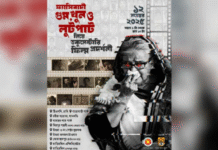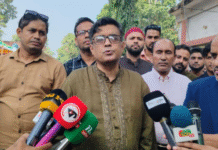
A Rohingya refugee man gets an oral cholera vaccine, distributed by the World Health Organisation (WHO) with the help of volunteers and local NGO’s, in a refugee camp near Cox’s Bazar on Wednesday. — Reuters photo
Mandatory biometric registration of Rohingyas entering Bangladesh to flee violence in Myanmar is going at a slow pace inside one month of its launching because of inadequate registration points and scattered shelters of the ethnic minority people.
The authorities have completed the registration for 1,17,526 of the over 5.21 lakh Rohingyas who have fled to Bangladesh until Tuesday since August 25 taking 9.39 lakh the number of Myanmar nationals living in the country.
Local people and migration rights activists also blamed lack of awareness and publicity among Rohingyas about the biometric registration for the slow pace.
Migration rights activists suggested that international community, especially the United Nations, should be engaged in the process of documentation in order to use the information more strongly in Rohingya repatriation process.
The parliamentary standing committee on home ministry on October 4 recommended expediting the biometric registration of Rohingyas.
The authorities are registering Rohingyas at five centres.
The number of registration centres should be increased, said Dhaka University international relation professor CR Abrar, also a migration expert.
‘Bangladesh needs to engage the international community like UNHCR in the documentation process so that it can get some benefit in the repatriation process,’ said CR Abrar, also the Refugee and Migratory Movements Research Unit executive director.
Home minister Asaduzzaman Khan said that the international agencies were always welcome to support the government move for registrations of Rohingyas.
‘We have begun on our own the registrations for Rohingya taking shelter in Cox’s Bazar as we cannot wait for others’ help. But the door is open for international agencies willing to support the process,’ the minister told New Age Monday.
According to UN estimation on Tuesday, 5,21,000 Rohingyas entered Bangladesh in the past seven weeks in the new influx what the United Nations called the world’s fastest-developing refugee emergency.
The new influx began after Myanmar security forces responded to Arakan Rohingya Salvation Army’s reported attacks on August 25 by launching a violence that the United Nations denounced as ethnic cleansing.
Officials estimated that the new influx already took to 9.39 lakh the number of Myanmar people living in Bangladesh.
Local people and leaders, however, said that the actual number of Rohingyas entering Bangladesh would be much more.
Rohingyas fled unrest in Rakhine state in 1978, 1991-
92 and October 2016 and almost all of them too shelter at Teknaf and Ukhia areas of Cox’s Bazar, which housed two registered Rohingya camps with 34,000 Rohingyas and several others unregistered camps and countless makeshift shelters.
In absence of sufficient number of registration points, Rohingyas need to spend hours together for getting registered.
Some of the Rohingya new arrivals are reluctant to be registered ‘Mtanmar Nationals’ only as their Rohingya ethnicity is not included in the document.
Rohingyas Abdul Karim, 40, and Abdus Sukkur, 52, now living at Kutupalang makeshift camp, said that they were unhappy as the cards handed over to them did not contain the Rohingya ethnicity.
The Department of Immigration and Passport deputy director Mohammad Ashrafuzzaman said that the process was not slow. ‘No Rohingyas or their leaders have contacted us regarding their dissatisfaction over their identity,’ he said.
‘We are working in line with the government instruction,’ he added.
The registered person’s name, father’s name, mother’s name, place and date of birth, religion, country, nationality and pace and date of registration are mentioned in the registration cards for Rohingyas.
The on September 11 started the biometric registration for the Rohingyas. The home minister said that without the registration cards, the Rohingyas would not get relief and would not be allowed to avail bus, water transports and even planes.
Rohingyas continued to enter Bangladesh on Tuesday through different land border points at Anjuman Para and sea border at Shah Parir Dwip of Teknaf, though their number decreased in compare to the past three days.
Addressing parliamentary network workshop arranged by World Bank and International Monetary Fund in Washington on Tuesday, Jatiya Sangsad speaker Shirin Sharmin Chaudhury urged the world leaders, inducing donor agencies, to take immediate effective steps for a permanent solution to Rohingya crisis, said a parliament release.
Bodies of two more Rohingyas were washed up on Shah Parir Dwip on Wednesday after a boat carrying desperate Rohingyas sank in the River Naf Sunday night, taking the confirmed death toll to 31 –– 17 children, 13 women and 1 man.
The boat with at least 60 Rohingyas sailed from Dongkhalir Char in Buthidaung capsized in the River Naf near Golar Para Char of Shah Parir Dwip.
Teknaf police station officer-in-charge Md Mainuddin said that of the bodies, 2 were recovered on Wednesday, 15 on Tuesday, 12 on Monday and 2 Sunday night.
The incident took to 164 the number of fleeing Rohingyas, mostly women and children, drowned in the bay and the River Naf since August 25.
Coast Guard members on Wednesday rescued at least 17 Rohingyas from the River Naf as they, in a desperate move, tried to cross the river to reach Bangladesh by using jerrycans as flotation devices.
Coast Guard east zone operations officer Alauddin Nayon said that they Rohingyas informed that they started swimming failing to hire boats in absence of boats on the Myanmar side.
Members of Border Guard Bangladesh arrested 19 Rohingyas, who illegally entered Bangladesh from India, at Paddoshakra border of Satkhira Sadar upazila Wednesday morning.
Paddoshakra border guard commander Mosharraf Hossain said that they arrested the 19 Rohingyas –– 10 children, 6 women and 3 men –– in the area at 9:00am.
Later, the arrested were sent to Satkhira police station, added the border guard official.
One after another waves of Rohingya influx have overcrowded Teknaf and Ukhia upazila’s health facilities and put extra pressure on water sources, which would reduce the ground water level further, said local government officials and elected local government representatives.
Rohingyas have completely destroyed forest of at least 1,500 acres or six square kilometre area and living in 12 square kilometre area of reserved forests, they said.
Rohingyas are posing threat of outbreak of diseases and hampering education, they added.
UNICEF said that it would install 10,000 latrines in the makeshift Rohingya camps in Cox’s Bazar to provide sanitation facilities for them. UNICEF signed a deal with disaster management and relief ministry on Wednesday in this regard.
The UN Human Rights Office said in a new report on Wednesday that brutal attacks by the Myanmar Army against Rohingyas in northern Rakhine state were well-organised, coordinated and systematic, with the intent of not only driving the population out of Myanmar but preventing them from returning to their homes by instilling deep and widespread fear and physical, emotional and psychological trauma among them.
UN Human Rights chief Zeid Ra’ad Al Hussein said that the Myanmar government’s ‘actions appear to be a cynical ploy to forcibly transfer large numbers of people without possibility of return.’
Source: New Age









